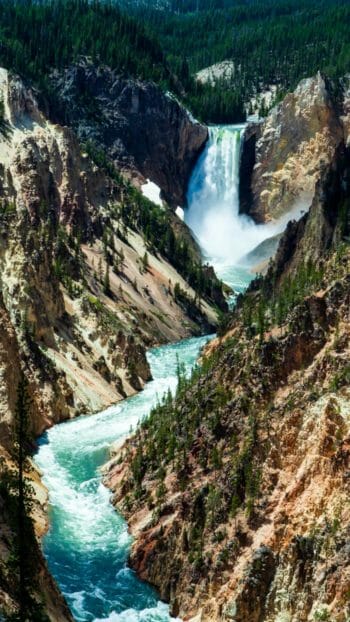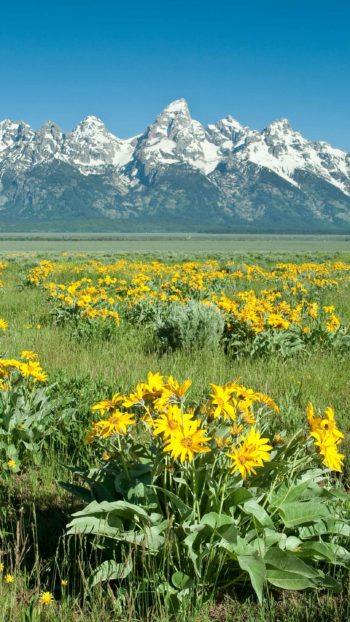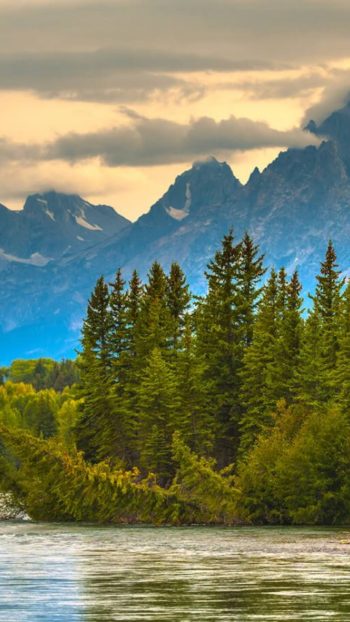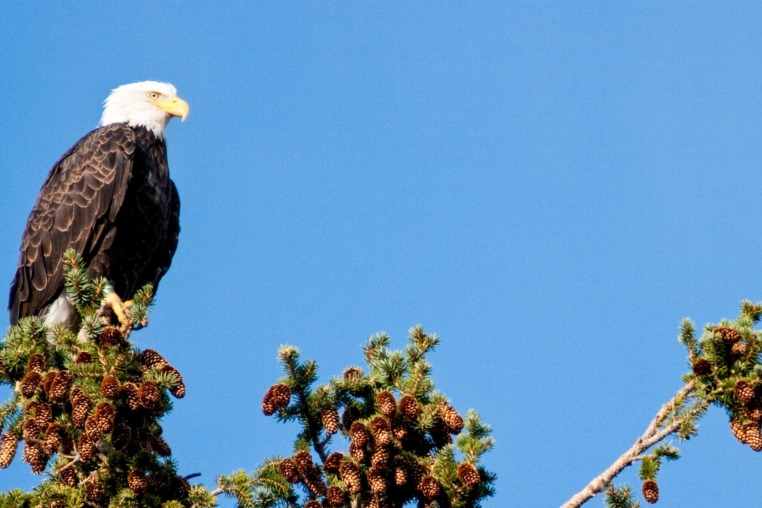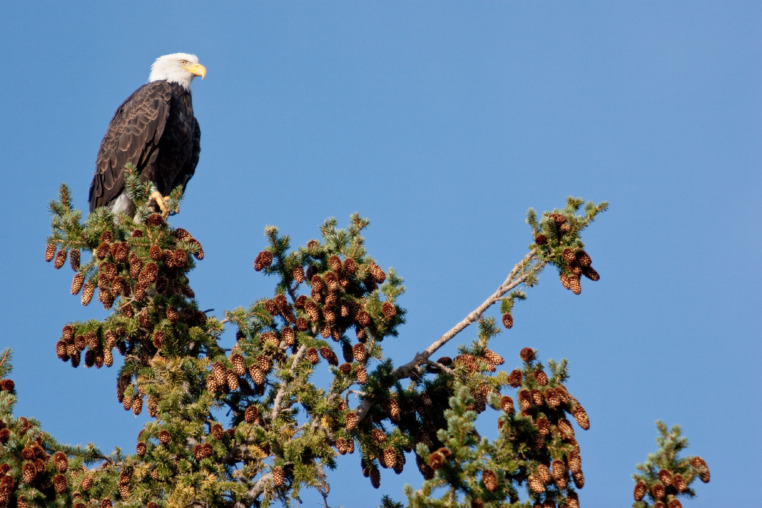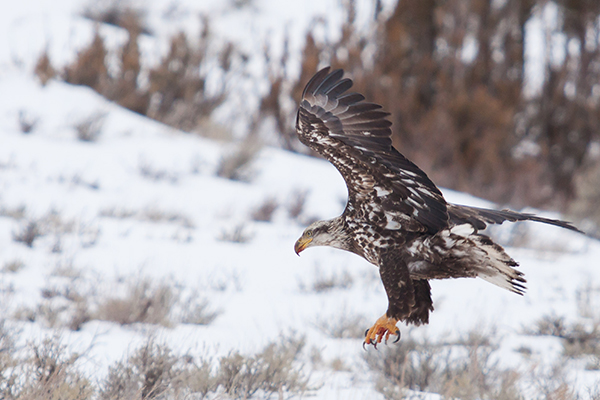
Haliaeetus leucocephalus
One of the most majestic and universally admired creatures of the Greater Yellowstone Ecosystem is the beautiful bald eagle. It earns its name from the characteristic white feathers on its head, giving a “bald” appearance, and its sheer size is enough to capture anyone’s attention. They weigh between 8-12 pounds, with an impressive wingspan of anywhere from 5.5-8 feet! This large raptor, found exclusively in North America, was once teetering on the brink of extinction until quick and drastic action was taken to save the iconic bird.
Wildlife Viewing
- Yellowstone
- Grand Teton
- Jackson Hole
Book Online
Watch For Wildlife On These Tours
About
A Conservation Success Story
Declared the national bird of the United States in 1782, there were about 100,000 nesting pairs at the time. Stressors such as hunting, habitat loss, and the widespread use of pesticides such as DDT throughout the 1900s took a massive toll. By 1963, only 487 nesting pairs remained. DDT seeped into waterways, poisoning the fish which eagles preyed on, consequently poisoning the eagles. This made the shell of their eggs too soft and most of them would break before they could hatch. After a ban on pesticides in the 1970’s and endowing the bald eagle with federal protection under the Endangered Species Act, they began to recover. In 2007, they were removed from the endangered species and threatened list. Now, they are a common sight across the US.
Scavengers and Thieves
80-90% of a bald eagle’s diet is fish. They live near bodies of water and rivers where they spend their time fishing and hunting waterfowl. They are opportunistic feeders, known to steal from other animals who have already done the work for them. They are often seen stalking ospreys, launching into hot pursuit when the osprey catches a fish to take it from them. They have also been documented stealing rodents from foxes and other small predators. They will feed on carrion, hanging out by a carcass until it is gone, particularly in the winter months when prey is scarce.
Mates for Life
Although generally solitary, bald eagles will breed with the same partner year after year and raise their chicks together. They spend winters apart, however. Think of it like taking separate vacations from each other! Like most birds of prey, females are actually larger than the males by about a third.
They build enormous nests, 4-6 feet in diameter and about 3 feet deep to raise their chicks. They use the same nest every year, building upon it each time. Sometimes they build a second next in their territory to let one rest and “air out” for a year. The chicks stay in the nest up to 12 weeks old, and will stay in the area to continue to learn from their parents for another 2 months. Juveniles will go through several moultings of their feathers, only growing their full white head and tail feathers by 5 years old when they become sexually mature.
Where Can I See Bald Eagles?
Keep an eye on the sky! Bald eagles are such large birds, it’s hard to miss them. Any time you are near a lake or a river, you are likely not far from an eagle. While you scan around, don’t forget to check around the tops of trees for the distinctive white feathers. Bald eagles will perch for long periods of time, scanning with their incredibly sharp eyesight for any movements of potential prey. Binoculars and spotting scopes are perfect tools for spotting this iconic bird.
FAQs
Where can I see bald eagles in Yellowstone and Grand Teton?
Bald eagles are most often found near lakes, rivers, and wetlands where fish are abundant. Look for them soaring overhead or perched in tall trees scanning for prey. Binoculars or spotting scopes greatly enhance the experience of seeing these impressive raptors.
What do bald eagles eat?
Around 80–90% of a bald eagle’s diet is fish, but they are opportunistic feeders. They also hunt waterfowl, scavenge carrion, and are notorious for stealing food from other animals, including ospreys and foxes.
How large are bald eagles?
Adult bald eagles weigh 8–12 pounds and boast an impressive wingspan of 5.5–8 feet. Females are about one-third larger than males, making them one of the largest birds of prey in North America.
Do bald eagles mate for life?
Yes, bald eagles typically mate for life and return to the same nesting sites each year. They build massive nests that can reach 6 feet across and reuse them, adding new layers annually. Both parents share in raising the chicks.
How did bald eagles recover from near extinction?
By the 1960s, bald eagle populations plummeted due to hunting, habitat loss, and pesticide use (especially DDT), with fewer than 500 nesting pairs remaining. After DDT was banned in the 1970s and the species was protected under the Endangered Species Act, populations rebounded. In 2007, bald eagles were officially removed from the endangered and threatened lists, marking a major conservation success story.
Further Reading
Jackson Hole Wildlife
Jul 12, 2024
Thanks to the range of different habitats that scatter across the sprawling valley, there is a plethora of wildlife to be found. The forests house woodland creatures like foxes, mule deer, black bears, pine martens, and elk.
A Month by Month Guide to Grand Teton National Park
Jun 21, 2024
Each and every month has something special to note, meaning that no matter what season you visit will be a special time. Use this guide to determine what time of year aligns best with what your interests and goals are.

